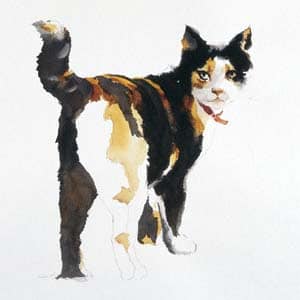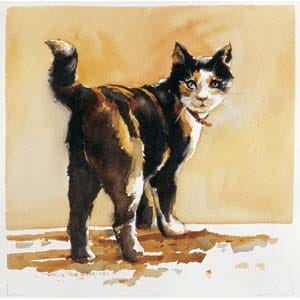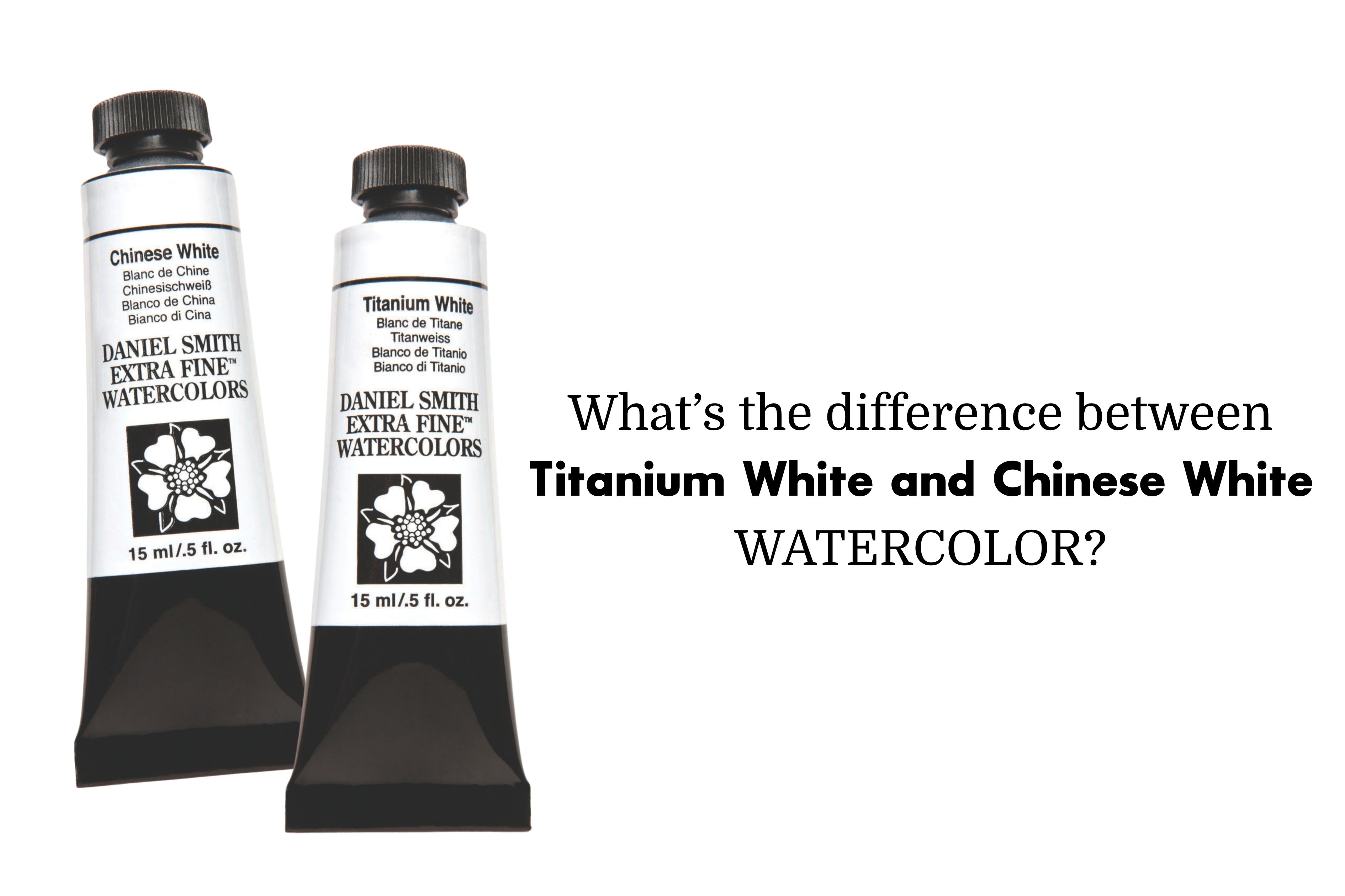My love for the medium of transparent watercolor is best expressed by painting spontaneously and very directly.
I work in various other media, but watercolor is by far the most exciting and exhilarating. I don’t wet, stretch or staple the paper to a board, just clip it and I’m good to go. Almost all of my paintings start in the middle of the value scale with a number four or five value applied to dry white paper. The four or five value reads well against white paper, which right away gives me a light and mid value. Then with the quick addition of some darks, I immediately see contrast and don’t have to laboriously go through building up numerous glazes to achieve the same end result. Also, the co-mingling of colors painted wet into wet on dry paper is just the ultimate in color application.
I seldom work with more than 5 colors in one painting and usually keep my selection to 3 colors. Daniel Smith’s Quinacridone Gold(QG), Quinacridone Sienna(QS), Quinacridone Rose(QR) and Ultramarine Blue(UB) were selected for this demonstration of painting Mouser the cat. The blue and sienna mixed on the paper together make an excellent black and the sienna mixed with the gold provides rich accents of color in the dark fur. The Quinacridone Rose is used for the ears, the nose, the collar and in the background. I have four considerations in every painting: Drawing, Value, Color and Edges.

STEP 1: Simple Line Drawing
Any good painting will have a sound drawing on which to build color. The drawing doesn’t have to be tight or very detailed, just a simple line drawing that is accurate will work. I try to get the drawing right the first time, but sometimes the subject will require several drawing attempts. Never knowingly leave your drawing wrong. If it’s wrong, fix it before moving on to the next step. Small drawings, such as thumbnails are helpful in establishing design, composition and format. My sketch of Mouser is in pen and ink, but could be done in pencil or felt tip pen as well.

STEP 2: Value Study in Black and White
This is Ivory Black against white paper. Value studies are extremely helpful in establishing the lights, mids and darks. These values should be in unequal portions. In other words – big piece, medium piece, small piece. This prevents a painting from being too much the same value all over and establishes good contrast. A painting should read strongly from a distance. This is one of the things that grabs the viewer’s attention as well as the subject matter and colors used. I work up a value study for almost everything I paint, either as a vertical, a horizontal, square or elongated. These don’t have to be large paintings; small value studies are very effective.

STEP 3: The Palette
Why work up a palette? It is extremely helpful in seeing the variations of color mixes, changes of temperature and different values in color. You get a good sense of what the painting is going to look like just from the palette. The top row of the palette shows the colors straight from the tube. Quinacridone Gold, Quinacridone Sienna, Quinacridone Rose and Ultramarine Blue.
Second Row: Quinacridone Gold plus Quinacridone Sienna; Quinacridone Gold plus Quinacridone Rose; Quinacridone Sienna plus Quinacridone Rose and Quinacridone Gold plus Ultramarine Blue.
Third row: Quinacridone Sienna plus a little Ultramarine Blue makes a nice rich brown. More ultramarine blue added to that mix makes an even darker brown and more ultramarine blue added makes a rich, dark black.
Fourth Row: Ultramarine Blue plus Quinacridone Sienna and more water, produces a nice cool gray. More Sienna added to that mixture produces a warmer gray. A little more Ultramarine Blue a little less water gives yet another cooler, darker gray.

STEP 4: First stage of painting
Using a #8 round brush, the darks on the cat’s head were painted by first putting Ultramarine Blue down, and then introducing Quinacridone Sienna while it was wet. Inside the ears, I used Quinacridone Gold and while wet, a little Quinacridone Rose was added. The yellow colors on the cat’s face and back are Quinacridone Gold and Quinacridone Sienna colors mixed together on the paper, wet into wet on dry paper. Variation of color and values is very important. As you can see, right away I have established mids and darks against white paper, giving the painting snap. The cat’s eyes are outlined in the black mixture and the marquis-shaped pupils are also painted black. Edges are already a consideration and I try to soften edges as I paint. Be sure to take note of the areas that have been left as white paper on the cat’s head as well as the body, legs and feet.

STEP 5: Continue application of the dark mixtures
Using a #12 round brush, I continue the application of the dark mixtures of Ultramarine Blue and then introduce Quinacridone Sienna into the blue at the shoulder area while it’s wet and glistening on the paper. Note – the bigger the area, the bigger the brush. And remember this – the more water you add, the lighter the values or color will be. Every color has a value. The less water, the darker. So remember you are now applying darker color, so you must use less water. I went back into the face, applying a little gray mixture of sienna and blue for shadow shapes. The mouth area is painted with a little mixture of rose and sienna, and a touch of black mixture. A little accent of sienna, gold mixture under the left eye area and above both eyes. The eyes are painted with Quinacridone Gold and a touch of Ultramarine Blue. Make one eye a little more important than the other. Never make both eyes equally the same. This same thought applies to painting people.

STEP 6: The cat’s tail and leg
The same process is repeated with the blue and sienna mixtures into the tail and leg of the cat. I also introduced more Quinacridone Gold into areas of the fur as needed. While the tail was still wet, I lifted out some color from the tail area with a semi-damp brush, producing a soft gray color. Note the change of cool and warm in the leg area. The left front leg is also painted with the black mixture and a touch of gold and sienna. The collar is painted with Quinacridone Rose with a touch of blue in the shadow area, then Quinacridone Rose alone, and then Quinacridone Rose plus a touch of Quinacridone Gold. A little gray mixture of Ultramarine Blue plus sienna is used for the right front foot with a touch of gold.

STEP 7: Finishing touches
Now for the finish. The back right leg is painted with the dark mixture, varying the values on the leg so that it will read against the left hind leg. Softening of edges at this stage very important. The shadows under the cat are painted with variations of gold, sienna, rose and blue – all wet into wet on dry paper. This is at least a number six or seven value, with darker accents of the same colors introduced while the paper is still wet.
The background is a wash of Quinacridone Gold, with Quinacridone Sienna and Quinacridone Rose introduced into the dry surface. The values are about a number four, and will require lots of juicy color (more water). A little Ultramarine Blue is introduced into the wet background for some cool relief.
After the painting is dry, I painted the whiskers using a #2 Script liner, white gouache and a little of the black mixture. Paint should be very thin and brush in excellent condition.
When finished, Mouser is an overall warm painting with an accent of cool. The mid-values are the biggest piece (large) the dark values are the middle piece (medium) and the whites are the small pieces (light). Note the distinct changes of value and color, the quality of the paint and its direct application. Final details, whiskers and highlights in the eyes. The highlight in the left eye is white, the one in the right eye is gray blue.
Limited palettes are a great way to learn how to mix color, plus your paintings will be more unified. For my own paintings, 3 primaries are usually sufficient, but to expand the palette, a warm and cool of each primary will allow you to mix most any color you could possibly need.
To excel at painting, you must be willing to put in the time – Practice, Practice, Practice. Painting does require a certain amount of talent, but much more important is the desire and the willingness to dedicate yourself to painting. Discipline and self-motivation are a necessary element. Ask yourself this question: “What am I willing to give up for it?”
It took me years to really understand what that means, but if you’re serious about painting, you’ll find the answer just like I did. Most of all have fun while you’re learning and I hope that you will receive blessings from painting as I have.








